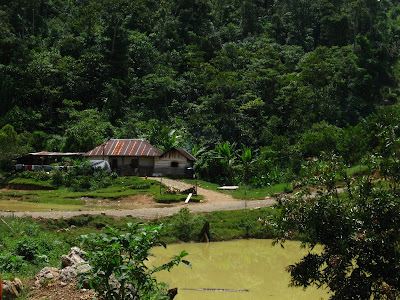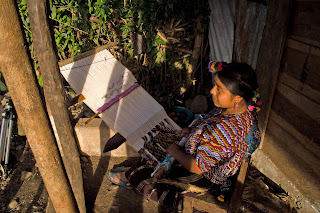 I am compiling a history and cultural section on Chajul. The name Chajul is made up of two ixil words. Jul which means to be encased in by mountains and Tzaj which means lighting. According to the tradition of their for fathers this site was sacred and in the surrounding mountains were religous ceremonial centers for the Ixil people. It was in the second century that the Ixil people were pushed out of their lands to the south by the Kiche tribe and came to this area.
I am compiling a history and cultural section on Chajul. The name Chajul is made up of two ixil words. Jul which means to be encased in by mountains and Tzaj which means lighting. According to the tradition of their for fathers this site was sacred and in the surrounding mountains were religous ceremonial centers for the Ixil people. It was in the second century that the Ixil people were pushed out of their lands to the south by the Kiche tribe and came to this area. Chajul is a pre-colonial town but was concord without a fight by the Spanish in 1530 after they defeated neighboring Nebaj. It was then Chajul reached its population height of 20,000-25,000 inhabitants. In 1750 the population began to recover from Spanish rule and began returning to the establishment of leaders from the indigenous inhabitants.
In 1890 ladinos (people of mix Spanish and Indian decent) came to the region and began contracting with the Ixil to work in the plantations along the coast. This started a season of labor exploitation that continued into the present generation. In the book “I Rigoberta Mnechu” chapter four she describes a griping tale of this life. Forty Indians would be crowded into a large truck with their animals and began the trip to the coast. The trucks were tarped and they were charged a loading and unloading fee so they stayed inside with the feces and vomit for a day and a half. Once on the plantation with company ran stores, clinics and cantinas so it was difficult to save any money during the one to three month stay. This work force was made up not only of men but consisted of the whole family. Today along the coast by you can find a Ixil community still wearing traditional dress that has relocated there permanently.
Today the name Chajul can refer both to the town of 11,000 people or the municipal (a municipal is similar to a county) that consist of 60 villages and 37,000 people. Chajul is part of what is referred to the Ixil triangle, three municipals Nebaj, Chajul and Cortzal that are home to the Ixil a Mayan people group. The road to Chajul was paved in ’98 increasing access but transportation slows as you make you way on to other villages. I get excited as I approach Chajul from Sacapulas. One reason is you start to climb out of the dry lands into the greenery of the mountains and another is the colorful clothing of the women and the stylish hats of the men tell you that you are entering a specific tribal homeland. Life slows down a bit and you are in the lands of the Ixil. It is beautifully different.
 When I first came to Chajul Higinio’s brother was the alcade or mayor of Chajul. It was under his direction that the fountain, benches and facelift of the porch were done. During the civil conflict that ravage Guatemala Chajul was particularly hard hit. The account in the book I Roberta Manchu where her brother was killed along with six other Guatemalans happened here. His body was burned in front of the Church. I have read that at night the army that garrisoned six to seven thousand solders here would hang the bodies of insurgents from this balcony and in the morning the local firemen would take them down. I am so thankful for peace.
When I first came to Chajul Higinio’s brother was the alcade or mayor of Chajul. It was under his direction that the fountain, benches and facelift of the porch were done. During the civil conflict that ravage Guatemala Chajul was particularly hard hit. The account in the book I Roberta Manchu where her brother was killed along with six other Guatemalans happened here. His body was burned in front of the Church. I have read that at night the army that garrisoned six to seven thousand solders here would hang the bodies of insurgents from this balcony and in the morning the local firemen would take them down. I am so thankful for peace.
When I come to Chajul from the outlaying villages we arrive here before dawn. I usually buy a glass of hot rice milk from a lady who sell it under the brick arch and then take a nap on one of the benches until daybreak. When the morning light starts to fill the sky the venders for the open air market begin arriving in the plaza below here and life begins again.
In 1890 ladinos (people of mix Spanish and Indian decent) came to the region and began contracting with the Ixil to work in the plantations along the coast. This started a season of labor exploitation that continued into the present generation. In the book “I Rigoberta Mnechu” chapter four she describes a griping tale of this life. Forty Indians would be crowded into a large truck with their animals and began the trip to the coast. The trucks were tarped and they were charged a loading and unloading fee so they stayed inside with the feces and vomit for a day and a half. Once on the plantation with company ran stores, clinics and cantinas so it was difficult to save any money during the one to three month stay. This work force was made up not only of men but consisted of the whole family. Today along the coast by you can find a Ixil community still wearing traditional dress that has relocated there permanently.
Today the name Chajul can refer both to the town of 11,000 people or the municipal (a municipal is similar to a county) that consist of 60 villages and 37,000 people. Chajul is part of what is referred to the Ixil triangle, three municipals Nebaj, Chajul and Cortzal that are home to the Ixil a Mayan people group. The road to Chajul was paved in ’98 increasing access but transportation slows as you make you way on to other villages. I get excited as I approach Chajul from Sacapulas. One reason is you start to climb out of the dry lands into the greenery of the mountains and another is the colorful clothing of the women and the stylish hats of the men tell you that you are entering a specific tribal homeland. Life slows down a bit and you are in the lands of the Ixil. It is beautifully different.
When I come to Chajul from the outlaying villages we arrive here before dawn. I usually buy a glass of hot rice milk from a lady who sell it under the brick arch and then take a nap on one of the benches until daybreak. When the morning light starts to fill the sky the venders for the open air market begin arriving in the plaza below here and life begins again.

The photo above is of the construction of the central park with the goal of bringing in tourism. These construction workers are probable making $10 a day on this government job but I have seen entry level wages at $3 a day.

 CHECK BACK FOR MORE INFOMATION LATER ADIOS
CHECK BACK FOR MORE INFOMATION LATER ADIOS











 Here is the start of a chicken project on which Higinio was working. Fifty meat chickens with feed and feeders cost around $100. Materials for a pen will run around $80. Sheep cost around $35 each and $15 to transport to the villages.
Here is the start of a chicken project on which Higinio was working. Fifty meat chickens with feed and feeders cost around $100. Materials for a pen will run around $80. Sheep cost around $35 each and $15 to transport to the villages.
